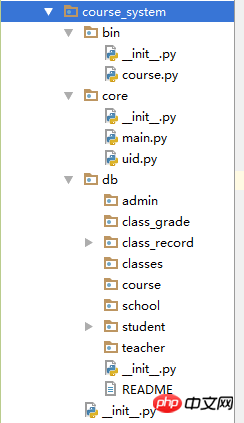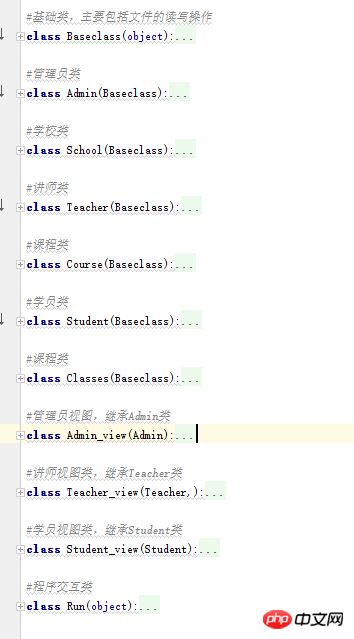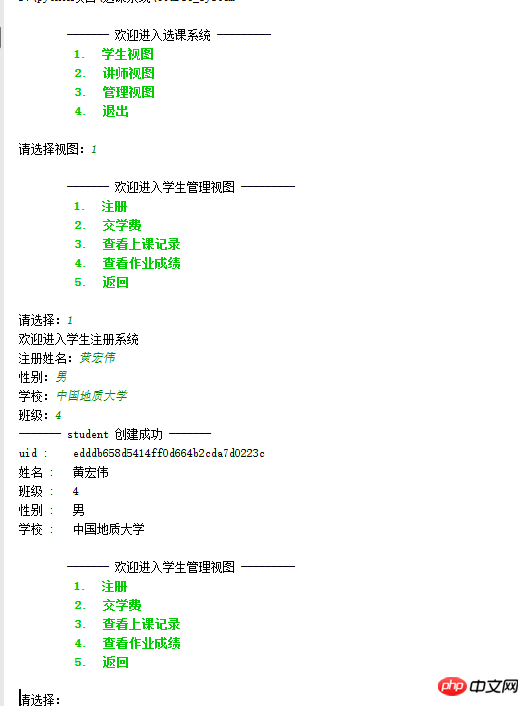 Operation and Maintenance
Operation and Maintenance
 Linux Operation and Maintenance
Linux Operation and Maintenance
 Implement an example of a python course selection system
Implement an example of a python course selection system
Implement an example of a python course selection system
下面介绍一下自己写的python程序,主要是的知识点为sys、os、json、pickle的模块应用,python程序包的的使用,以及关于类的使用。
下面是我的程序目录:

bin是存放一些执行文件course.py下面是这个文件的内容:
import sys,os
#程序主目录
BASE_DIR = os.path.dirname(os.path.dirname(os.path.abspath(__file__)))
print(BASE_DIR)
#添加环境变量
sys.path.append(BASE_DIR)
from core import main
if __name__ == '__main__':
a =main.Run()
a.interactive()这个文件是对os,sys模块的应用;
BASE_DIR = os.path.dirname(os.path.dirname(os.path.abspath(__file__)))
这里的os.path.abspath(__file__)是查看当前文件的所在位置。例如:
D:\python项目\选课系统\course_system\bin\course.py
这里的os.path.abspath是上一级目录例如:print(BASE_DIR)
D:\python项目\选课系统\course_system
sys.path.append(BASE_DIR) 括号里面是模块引用的地址,我们可以理解把这个模块得知设置成环境变量。 from core import main 导入core包中的main文件 这里是core包中udi.py文件
import hashlib
import time
def create_md():
m = hashlib.md5()
m.update(bytes(str(time.time()),encoding="utf-8"))
return m.hexdigest()在python中hashlib提供了常见的摘要算法,如MD5,SHA1等等。它通过一个函数,把任意长度的数据转换为一个长度固定的数据串(通常用16进制的字符串表示)。为了给学生生成一个随机不重复的uid。
这里是core包中main.py文件内容
import sys,os
import json #这里说一下json这个模块,java之中也有应用,所以一些数据也可以给java去用。
import pickle
from bin import course
from core import uid
#数据库文件路径
db_DIR = course.BASE_DIR + r"\db"
db_school = db_DIR + r"\school"
db_teacher = db_DIR + r"\teacher"
db_student = db_DIR + r"\student"
db_classes = db_DIR + r"\classes"
db_course = db_DIR + r"\course"
db_admin = db_DIR + r"\admin"
db_class_record = db_DIR + r"\class_record"
db_class_grade = db_DIR + r"\class_grade"
#基础类,主要包括文件的读写操作
class Baseclass(object): #在python3中全部是新式类,但是建议还是这样写。在python2中存在经典类和新式类;例如:class Baseclass: 这种在python中是经典类,而class Baseclass(object):这样是新式类。有关它们的区别,我会在下一篇博客中具体说明。
def __init__(self):
pass
def save(self,type,dict):
filename = uid.create_md()
dict['uid'] = filename
file_path = "%s\%s" %(db_DIR,type)
ab_file = "%s\%s" %(file_path,filename)
if os.path.isdir(file_path):
with open(ab_file,"wb") as f:
f.write(pickle.dumps(dict))
if True:
print(
"-------",type,"创建成功","-------")
for key in dict:
print(key,":\t",dict[key])
def seek_list(self,type,list):
filename = uid.create_md()
file_path = "%s\%s" %(db_DIR,type)
ab_file = "%s\%s" %(file_path,filename)
if os.path.isdir(file_path):
with open(ab_file,"wb") as f:
f.write(pickle.dumps(list))
if True:
print(
"-------",type,"创建成功","-------")
for i in list:
for key in i:
print(key,i[key])
print("\n")
return True
def open(self,type):
all_data = []
db_path = "%s\%s" %(db_DIR,type)
for i in os.listdir(db_path):
if os.path.isfile(os.path.join(db_path,i)):
db_file = os.path.join(db_path,i)
with open(db_file,"rb") as f:
file_dict = pickle.load(f)
all_data.append(file_dict)
return all_data
#admin类
class Admin(Baseclass):
def __init__(self):
Baseclass.__init__(self)
def create_school(self):
school_dict = {}
school_name = input("校名:")
school_address = input("地址:")
s1 = School(school_name, school_address)
school_dict["校名"] = s1.school_name
school_dict["地址"] = s1.school_address
Baseclass.save(self, "school", school_dict)
def create_teacher(self):
teacher_dict = {}
teacher_name = input("讲师姓名:")
teacher_salary = input("讲师工资:")
teacher_school = input("所属学校:")
t1 = Teacher(teacher_name, teacher_salary, teacher_school)
teacher_dict["姓名"] = t1.teacher_name
teacher_dict["工资"] = t1.teacher_salary
teacher_dict["所属学校"] = t1.teacher_school
print(teacher_dict)
Baseclass.save(self, "teacher", teacher_dict)
def create_student(self):
student_dict = {}
student_name = input("学员姓名:")
student_sex = input("学员性别:")
student_school = input("所属学校:")
student_classes = input("学员班级:")
st1 = Student(student_name, student_sex, student_school, student_classes)
student_dict["姓名"] = st1.student_name
student_dict["性别"] = st1.student_sex
student_dict["学校"] = st1.student_school
student_dict["班级"] = st1.student_classes
Baseclass.save(self, "student", student_dict)
def create_course(self):
course_dict = {}
course_name = input("课程名:")
course_period = input("周期:")
course_prices = input("价格:")
c1 = Course(course_name, course_period, course_prices)
course_dict["课程名"] = c1.course_name
course_dict["周期"] = c1.course_period
course_dict["价格"] = course_prices
Baseclass.save(self, "course", course_dict)
def create_classes(self):
classes_dict = {}
classes_name = input("班级名:")
classes_teachter = input("负责讲师:")
classes_course = input("所学课程:")
cs1 = Classes(classes_name, classes_teachter, classes_course)
classes_dict["班级名"] = cs1.classes_name
classes_dict["负责讲师"] = cs1.classes_teacher
classes_dict["课程"] = cs1.classes_course
Baseclass.save(self, "classes", classes_dict)
#School类
class School(Baseclass):
def __init__(self,school_name,school_address):
Baseclass.__init__(self)
self.school_name = school_name
self.school_address = school_address
#teacher类
class Teacher(Baseclass):
def __init__(self,teacher_name,teacher_salary,teacher_school):
Baseclass.__init__(self)
self.teacher_name = teacher_name
self.teacher_salary = teacher_salary
self.teacher_school = teacher_school
def create_class_record(self):
class_record = []
student_school = input("选择学校:")
student_classes = input("选择班级:")
student_times = input("课次:")
student_list = Baseclass.open(self,"student")
for i in student_list:
if i["学校"] == student_school and i["班级"] == student_classes:
student_name = i["姓名"]
student_status = input("%s 上课情况:" % student_name)
i["上课情况"] = student_status
i["课次"] = student_times
class_record.append(i)
Baseclass.seek_list(self,"class_record",class_record)
def create_class_grade(self):
class_grade = []
student_school = input("选择学校:")
student_classes = input("选择班级:")
student_times = input("课次:")
student_list = Baseclass.open(self,"student")
for i in student_list:
if i["学校"] == student_school and i["班级"] == student_classes:
student_name = i["姓名"]
student_grade = input("%s 成绩:" % student_name)
i["成绩"] = student_grade
i["课次"] = student_times
class_grade.append(i)
Baseclass.seek_list(self,"class_grade",class_grade)
def teacher_view_grade(self):
grade_list = []
student_school = input("校名:")
student_class = input("班级:")
student_times = input("课次:")
class_grade_list = Baseclass.open(self, "class_grade")
for i in class_grade_list:
for j in i:
if j["学校"] == student_school and j["班级"] == student_class and j["课次"] == student_times:
grade_list.append(j)
for i in grade_list:
for key in i:
print(key,i[key])
print("\n")
def tacher_view_record(self):
record_list = []
student_school = input("校名:")
student_class = input("班级:")
student_times = input("课次:")
class_record_list = Baseclass.open(self, "class_record")
for i in class_record_list:
for j in i:
if j["学校"] == student_school and j["班级"] == student_class and j["课次"] == student_times:
record_list.append(j)
for i in record_list:
for key in i:
print(key,i[key])
print("\n")
#classes类
class Course(Baseclass):
def __init__(self,course_name,course_period,course_prices):
Baseclass.__init__(self)
self.course_name = course_name
self.course_period = course_period
self.course_prices = course_prices
#student类
class Student(Baseclass):
def __init__(self,student_name,student_sex,student_school,student_classes):
Baseclass.__init__(self)
self.student_name = student_name
self.student_sex = student_sex
self.student_school = student_school
self.student_classes = student_classes
def student_registered(self):
student_dict = {}
print("欢迎进入学生注册系统")
student_name = input("注册姓名:")
student_sex = input("性别:")
student_school = input("学校:")
student_class = input("班级:")
st1 = Student(student_name,student_sex,student_school,student_class)
student_dict["姓名"] = st1.student_name
student_dict["性别"] = st1.student_sex
student_dict["学校"] = st1.student_school
student_dict["班级"] = st1.student_classes
Baseclass.save(self, "student", student_dict)
def student_pay_fees(self):
pass
def student_view_grade(self):
student_school = input("校名:")
student_class = input("班级:")
student_times = input("课次:")
student_name = input("姓名:")
class_grade_list = Baseclass.open(self,"class_grade")
for i in class_grade_list:
for j in i:
if j["学校"] == student_school and j["班级"] == student_class and j["课次"] == student_times \
and j["姓名"] == student_name:
for key in j:
print(key,j[key])
print("\n")
def student_view_record(self):
student_school = input("校名:")
student_class = input("班级:")
student_times = input("课次:")
student_name = input("姓名:")
class_record_list = Baseclass.open(self,"class_record")
for i in class_record_list:
for j in i:
if j["学校"] == student_school and j["班级"] == student_class and j["课次"] == student_times \
and j["姓名"] == student_name:
for key in j:
print(key,j[key])
print("\n")
#课程类
class Classes(Baseclass):
def __init__(self,classes_name,classes_teachter,classes_course):
Baseclass.__init__(self)
self.classes_name = classes_name
self.classes_teacher = classes_teachter
self.classes_course = classes_course
#管理员视图,继承Admin类
class Admin_view(Admin):
def __init__(self):
Admin.__init__(self)
def auth(self,username,password):
admin_file = "%s/%s.json" %(db_admin,username)
if os.path.isfile(admin_file):
with open(admin_file, 'r') as f:
admin_data = json.load(f)
if admin_data["name"] == username and admin_data["password"] == password:
return True
else:
print("用户名或密码错误")
def login(self):
menu = u'''
------- 欢迎进入管理视图 ---------
\033[32;1m 1. 校区管理
2. 讲师管理
3. 学员管理
4. 课程管理
5. 返回
\033[0m'''
menu_dic = {
'1': Admin_view.school_manager,
'2': Admin_view.teacher_manager,
'3': Admin_view.student_manager,
'4': Admin_view.course_manager,
'5': "logout",
}
username = input("输入用户名:").strip()
password = input("输入密码:").strip()
auth = Admin_view.auth(self,username,password)
if auth:
exit_flag = False
while not exit_flag:
print(menu)
option = input("请选择:").strip()
if option in menu_dic:
if int(option) == 5:
exit_flag = True
else:
print(menu_dic[option])
menu_dic[option](self)
else:
print("\033[31;1m输入错误,重新输入\033[0m")
def school_manager(self):
exit_flag = False
while not exit_flag:
print("""
------- 欢迎进入校区管理 ---------
\033[32;1m1. 创建校区
2. 创建班级
3. 返回
\033[0m
""")
option = input("请选择:").strip()
if int(option) == 1:
Admin.create_school(self)
elif int(option) == 2:
Admin.create_classes(self)
else:
exit_flag = True
def teacher_manager(self):
exit_flag = False
while not exit_flag:
print("""
------- 欢迎进入讲师管理 ---------
\033[32;1m 1. 创建讲师
2. ...
3. 返回
\033[0m
""")
option = input("请选择:").strip()
if int(option) == 1:
Admin.create_teacher(self)
elif int(option) == 2:
print("扩展中")
else:
exit_flag = True
def student_manager(self):
exit_flag = False
while not exit_flag:
print("""
------- 欢迎进入学员管理 ---------
\033[32;1m 1. 创建学员
2. ...
3. 返回
\033[0m
""")
option = input("请选择:").strip()
if int(option) == 1:
Admin.create_student(self)
elif int(option) == 2:
print("扩展中")
else:
exit_flag = True
def course_manager(self):
exit_flag = False
while not exit_flag:
print("""
------- 欢迎进入课程管理 ---------
\033[32;1m 1. 创建课程
2. ...
3. 返回
\033[0m
""")
option = input("请选择:").strip()
if int(option) == 1:
Admin.create_course(self)
elif int(option) == 2:
print("扩展中")
else:
exit_flag = True
#讲师视图类,继承Teacher类
class Teacher_view(Teacher,):
def __init__(self,teacher_name,teacher_salary,teacher_school):
Teacher.__init__(self,teacher_name,teacher_salary,teacher_school)
def login(self):
menu = u'''
------- 欢迎进入讲师视图 ---------
\033[32;1m 1. 创建上课记录
2. 创建学员成绩
3. 查看学员上课记录
4. 查看学员成绩
5. 返回
\033[0m'''
menu_dic = {
'1': Teacher.create_class_record,
'2': Teacher.create_class_grade,
'3': Teacher.tacher_view_record,
'4': Teacher.teacher_view_grade,
'5': "logout",
}
if True:
exit_flag = False
while not exit_flag:
print(menu)
option = input("请选择:").strip()
if option in menu_dic:
if int(option) == 5:
exit_flag = True
else:
print(menu_dic[option])
menu_dic[option](self)
else:
print("\033[31;1m输入错误,重新输入\033[0m")
#学员视图类,继承Student类
class Student_view(Student):
def __init__(self,student_name,student_sex,student_school,student_classes):
Student.__init__(self,student_name,student_sex,student_school,student_classes)
def login(self):
menu = u'''
------- 欢迎进入学生管理视图 ---------
\033[32;1m 1. 注册
2. 交学费
3. 查看上课记录
4. 查看作业成绩
5. 返回
\033[0m'''
menu_dic = {
'1': Student.student_registered,
'2': Student.student_pay_fees,
'3': Student.student_view_record,
'4': Student.student_view_grade,
'5': "logout",
}
if True:
exit_flag = False
while not exit_flag:
print(menu)
option = input("请选择:").strip()
if option in menu_dic:
if int(option) == 5:
exit_flag = True
else:
menu_dic[option](self)
else:
print("\033[31;1m输入错误,重新输入\033[0m")
#程序交互类
class Run(object):
def __init__(self):
pass
def interactive(self):
menu = u'''
------- 欢迎进入选课系统 ---------
\033[32;1m 1. 学生视图
2. 讲师视图
3. 管理视图
4. 退出
\033[0m'''
menu_dic = {
'1': Student_view,
'2': Teacher_view,
'3': Admin_view,
# '4': logout,
}
exit_flag = False
while not exit_flag:
print(menu)
option_view = input("请选择视图:").strip()
if option_view in menu_dic:
if int(option_view) == 4:
exit_flag = True
else:
menu_dic[option_view].login(self)
else:
print("\033[31;1m输入错误,重新输入\033[0m")
写程序的的时候最好先把一个框架先写出来,最后再往里边填写东西。
这是程序执行效果

不在过多演示了
因为毕竟是刚刚学习python,这里也借鉴了很多网友的代码,所以也非诚感谢这些人。
The above is the detailed content of Implement an example of a python course selection system. For more information, please follow other related articles on the PHP Chinese website!

Hot AI Tools

Undresser.AI Undress
AI-powered app for creating realistic nude photos

AI Clothes Remover
Online AI tool for removing clothes from photos.

Undress AI Tool
Undress images for free

Clothoff.io
AI clothes remover

AI Hentai Generator
Generate AI Hentai for free.

Hot Article

Hot Tools

Notepad++7.3.1
Easy-to-use and free code editor

SublimeText3 Chinese version
Chinese version, very easy to use

Zend Studio 13.0.1
Powerful PHP integrated development environment

Dreamweaver CS6
Visual web development tools

SublimeText3 Mac version
God-level code editing software (SublimeText3)

Hot Topics
 Is the conversion speed fast when converting XML to PDF on mobile phone?
Apr 02, 2025 pm 10:09 PM
Is the conversion speed fast when converting XML to PDF on mobile phone?
Apr 02, 2025 pm 10:09 PM
The speed of mobile XML to PDF depends on the following factors: the complexity of XML structure. Mobile hardware configuration conversion method (library, algorithm) code quality optimization methods (select efficient libraries, optimize algorithms, cache data, and utilize multi-threading). Overall, there is no absolute answer and it needs to be optimized according to the specific situation.
 Is there any mobile app that can convert XML into PDF?
Apr 02, 2025 pm 08:54 PM
Is there any mobile app that can convert XML into PDF?
Apr 02, 2025 pm 08:54 PM
An application that converts XML directly to PDF cannot be found because they are two fundamentally different formats. XML is used to store data, while PDF is used to display documents. To complete the transformation, you can use programming languages and libraries such as Python and ReportLab to parse XML data and generate PDF documents.
 How to convert XML files to PDF on your phone?
Apr 02, 2025 pm 10:12 PM
How to convert XML files to PDF on your phone?
Apr 02, 2025 pm 10:12 PM
It is impossible to complete XML to PDF conversion directly on your phone with a single application. It is necessary to use cloud services, which can be achieved through two steps: 1. Convert XML to PDF in the cloud, 2. Access or download the converted PDF file on the mobile phone.
 What is the function of C language sum?
Apr 03, 2025 pm 02:21 PM
What is the function of C language sum?
Apr 03, 2025 pm 02:21 PM
There is no built-in sum function in C language, so it needs to be written by yourself. Sum can be achieved by traversing the array and accumulating elements: Loop version: Sum is calculated using for loop and array length. Pointer version: Use pointers to point to array elements, and efficient summing is achieved through self-increment pointers. Dynamically allocate array version: Dynamically allocate arrays and manage memory yourself, ensuring that allocated memory is freed to prevent memory leaks.
 How to control the size of XML converted to images?
Apr 02, 2025 pm 07:24 PM
How to control the size of XML converted to images?
Apr 02, 2025 pm 07:24 PM
To generate images through XML, you need to use graph libraries (such as Pillow and JFreeChart) as bridges to generate images based on metadata (size, color) in XML. The key to controlling the size of the image is to adjust the values of the <width> and <height> tags in XML. However, in practical applications, the complexity of XML structure, the fineness of graph drawing, the speed of image generation and memory consumption, and the selection of image formats all have an impact on the generated image size. Therefore, it is necessary to have a deep understanding of XML structure, proficient in the graphics library, and consider factors such as optimization algorithms and image format selection.
 How to convert xml into pictures
Apr 03, 2025 am 07:39 AM
How to convert xml into pictures
Apr 03, 2025 am 07:39 AM
XML can be converted to images by using an XSLT converter or image library. XSLT Converter: Use an XSLT processor and stylesheet to convert XML to images. Image Library: Use libraries such as PIL or ImageMagick to create images from XML data, such as drawing shapes and text.
 How to open xml format
Apr 02, 2025 pm 09:00 PM
How to open xml format
Apr 02, 2025 pm 09:00 PM
Use most text editors to open XML files; if you need a more intuitive tree display, you can use an XML editor, such as Oxygen XML Editor or XMLSpy; if you process XML data in a program, you need to use a programming language (such as Python) and XML libraries (such as xml.etree.ElementTree) to parse.
 Recommended XML formatting tool
Apr 02, 2025 pm 09:03 PM
Recommended XML formatting tool
Apr 02, 2025 pm 09:03 PM
XML formatting tools can type code according to rules to improve readability and understanding. When selecting a tool, pay attention to customization capabilities, handling of special circumstances, performance and ease of use. Commonly used tool types include online tools, IDE plug-ins, and command-line tools.





